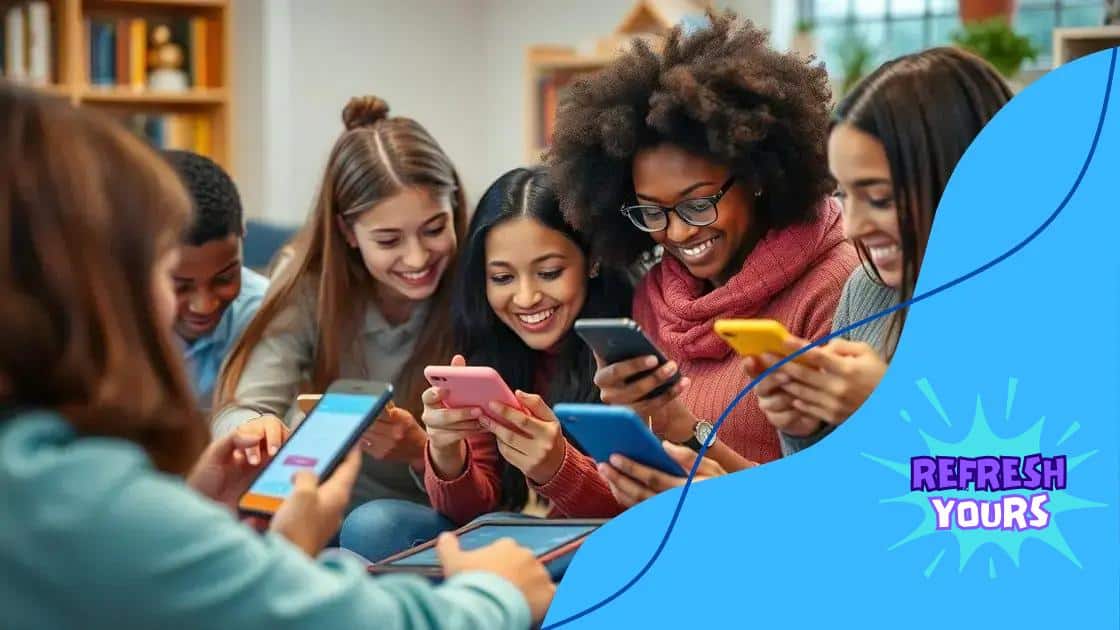The impact of mobile learning apps on remote education

The impact of mobile learning apps on remote education is significant, offering enhanced accessibility, increased engagement, and personalized learning experiences supported by emerging technologies like AI and VR.
The impact of mobile learning apps on remote education is significant. Have you noticed how these tools are transforming the way students learn from home? In this article, we’ll dive into their benefits and challenges.
Understanding mobile learning apps
Understanding mobile learning apps is crucial in today’s education landscape. These applications provide invaluable tools for learners, especially in remote environments. They connect students with resources and make learning accessible anytime, anywhere.
Key Features of Mobile Learning Apps
Mobile learning apps come with several features that enhance the learning experience. Understanding these features can help educators and students maximize their benefits.
- Interactive content: Engaging quizzes and tasks.
- Personalized learning: Tailored experiences based on individual progress.
- Offline access: Downloadable materials for learning without internet.
- Instant feedback: Real-time evaluation of skills and knowledge.
Additionally, mobile learning apps support various learning styles. Some students prefer visual content, while others are more audio-oriented. With a variety of multimedia options available, students can select what works best for them. This adaptability helps them stay motivated and engaged.
Popular Mobile Learning Apps
Several notable apps have emerged in the mobile learning space. These apps cater to different educational needs and preferences. Some popular ones include:
- Khan Academy: Offers a broad range of subjects and courses.
- Duolingo: Focuses on language learning with a fun approach.
- Quizlet: Provides tools for studying and creating flashcards.
By leveraging these apps, learners can enrich their educational journey. Think of how much more engaging and effective learning becomes when students can use technology to interact with their studies. Mobile learning truly opens up a world of possibilities, making it easier for anyone to learn at their own pace.
Benefits for remote education
The benefits for remote education are numerous and significant. With the rise of technology, students have access to tailored learning experiences that suit their individual needs. This flexibility can lead to better engagement and improved academic performance.
Increased Accessibility
One of the key benefits is the increased accessibility of education. Students from any location can connect to learning materials at any time. This is especially advantageous for those with restrictions on travel or schedules. Furthermore, students can revisit lessons as many times as necessary for better understanding.
- Access from anywhere: Learning is not confined to a classroom.
- Flexible schedules: Students can learn at their own pace.
- Diverse resources: A wider range of materials available online.
Another major advantage is the ability to personalize learning pathways. Remote education often incorporates adaptive learning technologies that respond to individual student performance. This supports various learning styles and helps students to master subjects before moving on.
Enhanced Engagement
Incorporating interactive tools and multimedia elements keeps students engaged in ways that traditional methods may not. Through mobile learning apps and online platforms, students can enjoy:
- Interactive lessons: Building understanding through quizzes and games.
- Visual aids: Engaging videos and infographics enhance retention.
- Social learning: Discussion boards foster collaboration and communication.
These elements not only enrich the educational experience but also motivate students to take responsibility for their learning. The engagement level is a crucial factor in ensuring educational success.
Furthermore, remote education can be more cost-effective. Parents and students may save on commuting expenses, and educational institutions can optimize costs associated with physical infrastructure. This allows for reallocating funds to enhance digital learning tools.
Challenges faced by users

While there are many advantages to using mobile learning apps for remote education, users also face several challenges. Understanding these issues is essential for improving the overall experience and effectiveness of online learning.
Technical Issues
Technical difficulties can be a major barrier for students. Problems such as poor internet connections or outdated devices can hinder learning. These issues can lead to:
- Disconnected sessions: Students may struggle to stay connected during lessons.
- Slow loading times: Content may take too long to load, causing frustration.
- App compatibility: Some apps may not work well on older devices.
To combat these challenges, it is important for users to ensure they have reliable technology and a stable internet connection whenever possible.
User Engagement
Another challenge is maintaining user engagement. While mobile learning apps offer interactive content, some learners may still find it difficult to stay focused. Factors contributing to this can include:
- Distractions: Home environments may not be conducive to studying.
- Lack of motivation: Without a physical classroom setting, some students may struggle to stay motivated.
- Overwhelming options: Too many features can confuse users and disrupt learning.
To enhance engagement, learners can establish a dedicated study space and set specific goals for their sessions, allowing them to stay organized and focused.
Moreover, navigating the vast array of learning resources can be daunting. With so many choices available, students might find it difficult to select the best materials that suit their needs.
Real-world success stories
Real-world success stories highlight how mobile learning apps significantly enhance remote education. These stories illustrate how various learners achieved their academic goals using innovative technologies.
Case Study: High School Students
A group of high school students in a rural area struggled with limited access to educational resources. By utilizing a popular mobile learning app, they gained access to interactive lessons and practice tests. Their teachers reported:
- Improved test scores: Many students scored higher in their subjects.
- Increased participation: Students became more involved in their studies.
- Greater confidence: Learning through technology empowered these students.
This case shows the transformative power of mobile apps in remote education.
Case Study: Adult Learners
Another example comes from a group of adult learners pursuing career development. By training with a language learning app, they effectively acquired new skills necessary for job advancement. Feedback from participants included:
- Convenience: Learning could fit their busy schedules.
- Flexible pacing: They progressed at a comfortable speed.
- Community support: Interacting with peers through forums enhanced their experience.
These adults not only improved their language skills but also increased their job prospects.
Success stories can often inspire others to explore mobile learning solutions. Seeing real people achieve their goals reminds students that they too can benefit from these powerful tools in their educational journey.
Future trends in mobile learning
Future trends in mobile learning are poised to change education significantly. As technology continues to evolve, new opportunities will arise for enhancing remote education.
Artificial Intelligence Integration
One major trend is the growing integration of artificial intelligence (AI) in mobile learning apps. AI can provide personalized experiences by analyzing user behavior and preferences. This customization can lead to:
- Adaptive learning paths: Students receive content tailored to their needs.
- Smart assessments: AI can evaluate performance and provide feedback.
- Interactive tutoring: Virtual tutors offer support during learning.
With AI, learners receive a unique experience that caters specifically to their strengths and weaknesses.
Augmented and Virtual Reality
Another exciting trend is the use of augmented reality (AR) and virtual reality (VR) in mobile learning. These technologies can transform how students engage with content. For instance, AR can overlay information in real-world environments, while VR can immerse students in different learning scenarios. Benefits include:
- Enhanced engagement: Interactive experiences keep learners interested.
- Immersive learning: Realistic simulations provide deeper understanding.
- Safe exploration: Students can explore virtual worlds without risks.
These technologies allow students to experience lessons in dynamic ways, making learning more fun and impactful.
Moreover, social learning features are likely to gain more traction. With remote education being prevalent, apps that connect students with peers for collaborative projects and discussions will continue to thrive. Building strong learning communities fosters engagement and motivation.
FAQ – Frequently Asked Questions about Mobile Learning Apps in Remote Education
How do mobile learning apps enhance accessibility for students?
Mobile learning apps allow students to access educational resources anytime and anywhere, making learning more flexible and convenient.
What role does user engagement play in mobile learning apps?
User engagement in mobile learning apps keeps students motivated through interactive content and personalized learning experiences.
What future technologies are expected to shape mobile learning?
Future technologies like artificial intelligence, augmented reality, and virtual reality are anticipated to create more dynamic and immersive learning environments.
How can mobile learning apps support collaboration among students?
Mobile learning apps can include social learning features that allow students to interact with peers, share ideas, and work together on projects.





